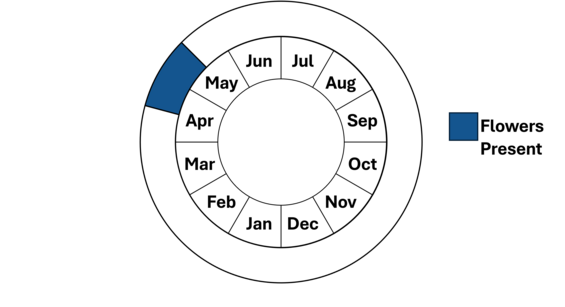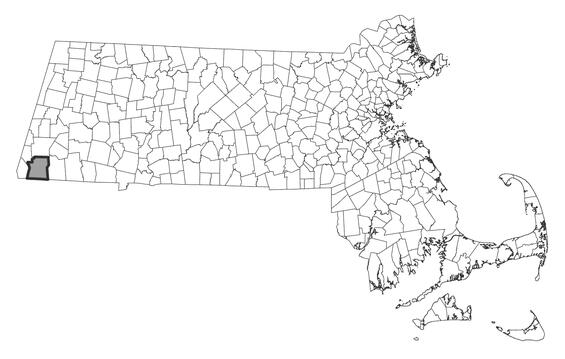- Scientific name: Cardamine douglassii
- Species of Greatest Conservation Need (MA State Wildlife Action Plan)
- Endangered (MA Endangered Species Act)
Description
Purple cress is a perennial herb of rich floodplains and low wet woods. A member of the mustard family (Brassicaceae), purple cress is a spring ephemeral that gets its name from the green to purplish-green hairy stem and pale purple flowers. The shallow rhizomes are white but turn green if exposed. Stems are moderately pubescent, slender, and range from 10-30 cm (4-12 in) tall. Basal leaves are heart-shaped or oval and bluntly dentate or undulate with long, slender petioles. The lower stem leaves are similar, but short petioled. The leaves are variable with most having shallow lobes or sinuous margins. The leaves are alternate, up to 5cm (~2 in) long and 2.5 cm (~1 in) across, but continue to become shorter and narrower toward the top of the stem. Upper leaves are sessile or slightly clasping. The central stem terminates in a raceme of flowers. Flowers have four regular parts, are approximately 1.25 cm (0.5 in) across, and are pale purple or purple tinged white. Sepals are green to purple and fade to brown. The siliques (seed pods of the mustard family) are nearly erect. Siliques are approximately 2 cm (~ 0.75 in) long, green to purple, and contain a narrow row of very small seeds. The siliques mature and split open to release the seeds by midsummer. Look for purple cress in early spring usually near water. Spring cress (C. bulbosa) occurs in similar habitats, but has white flowers, green sepals, and blooms two to three weeks later than purple cress. Hybridization between C. bulbosa and C. douglassii is known.

Population status
Purple cress is listed under the Massachusetts Endangered Species Act as endangered. All listed species are protected from killing, collecting, possessing, or sale and from activities that would destroy habitat and thus directly or indirectly cause mortality or disrupt critical behaviors. It is currently known from Berkshire County.
Distribution and abundance
Purple cress occurs north to Ontario, west to Iowa, south to Alabama, and north along the east coast to Massachusetts.

Distribution in Massachusetts
1999-2024
Based on records in the Natural Heritage Database
Habitat
Purple cress is typically found in rich floodplains and upland edges of calcareous swamps. It prefers full to partial shade and mesic to hydric soils. Look for it in wet, deciduous woods and near springs.
Associated species include sugar maple (Acer saccharum), American basswood (Tilia americana), ash species (Fraxinus spp.), American hornbeam (Carpinus caroliniana), yellow birch (Betula alleghaniensis), bitternut hickory (Carya cordiformis), American elm (Ulmus americana), black cherry (Prunus serotina), winterberry (Ilex verticillata), goldenrods (Solidago spp.), asters (Symphyotrichum spp.), garlic mustard (Alliaria petiolata), Japanese barberry (Berberis thunbergii), wood anemone (Anemone quinquefolia), cinnamon fern (Osmunda cinnamomea), sensitive fern (Onoclea sensibilis), arrowwoods (Viburnum spp.), christmas fern (Polystichum acrostichoides), creeping jenny (Lysimachia nummularia), and various sedges (Carex spp.).
Healthy habitats are vital for supporting native wildlife and plants. Explore habitats and learn about conservation and restoration in Massachusetts.
Threats
Because they share a similar habitat, the non-native invasive species garlic mustard (Alliaria petiolata) may be encroaching on purple cress populations. Hybridization with spring cress may also be a possible threat to purple cress.
Conservation
Sites should be monitored for invasions of exotic plants; if exotic plants are out-competing this species, a plan should be developed, in consultation with the MassWildlife’s Natural Heritage & Endangered Species Program, to remove the invaders. Known habitat locations should be protected from dramatic changes in light or moisture conditions. All active management of state-listed plant populations (including invasive species removal) is subject to review under the Massachusetts Endangered Species Act and should be planned in close consultation with the MassWildlife’s Natural Heritage & Endangered Species Program.
References
Britton, N.L., and A. Brown. 1970. An Illustrated Flora of the Northern United States and Canada. Dover Publications, New York, New York, USA.
Gleason H.A., and A. Cronquist. 1991. Manual of Vascular Plants of Northeastern United States and Adjacent Canada. New York Botanical Garden Press, Bronx, New York
NatureServe. 2009. NatureServe Explorer: An online encyclopedia of life [web application]. Version 7.1. NatureServe, Arlington, Virginia. Available http://www.natureserve.org/explorer. (Accessed: January 07, 2011)
Contact
| Date published: | April 8, 2025 |
|---|